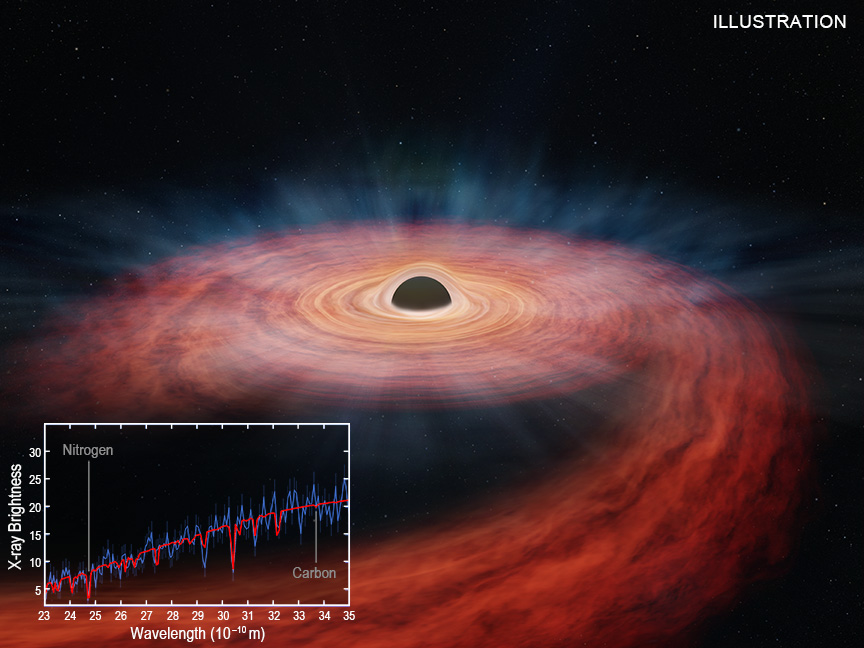
 Credit: NASA/CXC/Univ of Michigan/J. Miller et al.; Illustration: NASA/CXC/M.Weiss
Credit: NASA/CXC/Univ of Michigan/J. Miller et al.; Illustration: NASA/CXC/M.Weiss
Leave the Well Alone
Spacetime surely can be dangerous. Incautious stars wandering too close to a black hole, for example, may fall into the distorted gravitational well of the curved spacetime around the black hole, spilling down into the event horizon and effectively out of existence - we think. Because the side of the star near the black hole falls into the well before the far side, the star as it falls is ripped apart, stretched and compressed by tidal forces as it spirals down the drain of spacetime. The unfortunate star does not go gentle into that dark night, but rages in a burst of energy billions of times more intense than anything the star produced before. We don't know how often these terrible events happen, but careful monitoring of the sky by optical and X-ray telescopes have revealed dozens of these "tidal disruption events" (TDEs for short) over the past few decades. Mostly, these poor stars are anonymous as they descend to their unfortunate grave. But a TDE outburst discovered in 2014 by the All-Sky Automated Survey for Supernovae (or ASASSN as it is known) left behind some important tell-tale X-ray clues to that unfortunate star's identity. High exposure X-ray observations of this TDE event with the high-resolution spectrometers on the XMM-Newton X-ray observatory and the Chandra X-ray Observatory. These instruments measure the X-ray spectrum, the X-ray brightness at every X-ray energy within the range of the instrument's sensitivity. Spectra (in X-rays or other forms of radiation) serve as the finger print of an object, and encodes important information about the object, like source temperature (or color, in visible light) and composition. The image above is an artist's interpretation of a TDE, showing material from a torn-apart star spiraling into a black hole at the center of the in-flowing disk of material. The inset shows the X-ray spectrum of the 2014 ASASSN TDE from the Chandra X-ray Observatory (in blue), along with a theoretical model (in red). The small, seemingly unremarkable dips in the spectrum are actually vitally important information, since they arise from atoms in the source which absorb X-rays, and the wavelength of the center of the dips identifies which atomic element produced the dip. In the spectrum, a dip produced by nitrogen atoms is marked, along with the position of an expected dip which would have been produced by carbon atoms. Because the chemical composition of stars at a given time depends on the mass of the star, the presence of nitrogen and absence of carbon in the X-ray spectrum of the disrupted star suggests that this particular black hole was feasting on a star at least three times the mass of our Sun.
Published: October 23, 2023
<
HEA Dictionary ● Archive
● Search HEAPOW
● Other Languages
● HEAPOW on Facebook
● Download all Images
● Education ● HEAD
>

Each week the HEASARC
brings you new, exciting and beautiful images from X-ray and Gamma ray
astronomy. Check back each week and be sure to check out the HEAPOW archive!
Page Author: Dr. Michael F. Corcoran
Last modified Tuesday, 27-Feb-2024 10:15:12 EST


